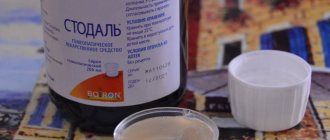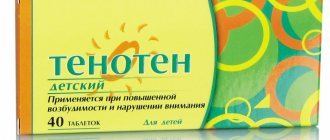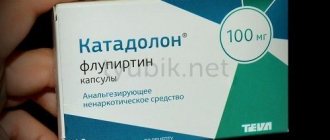Sporobacterin. 10 ml. We present to your attention the probiotic Sporobacterin, which contains a live culture of the Bacillus subtilis 534 strain.
The therapeutic effect of probiotic drugs containing live bacteria is based on the properties of microbial cultures. Saprophytic microorganisms produce biologically active substances, immunomodulators, vitamins, essential amino acids and, most importantly, broad-spectrum antibiotics.
The results of the latest research in medicine show that some bacteria are able to penetrate directly into the blood and lymph, reach the source of inflammation and have a therapeutic effect there. Most of all, this mechanism of action is characteristic of bacteria of the genus Bacillus.
Employees of the Orenburg State Medical Institute developed the drug sporobacterin, which has been recommended by the Ministry of Health of the Russian Federation since 1992 (VFS 42-371 VS-92) for use in clinical practice.
The creation of sporobacterin became possible after the discovery of a previously unknown mechanism of protection of warm-blooded organisms from infection (V.I. Nikitenko et al., 1986).
Sporobacterin is based on bacteria of the Bacillus subtilis 534 strain. As a result of many years of research, it has been proven that these bacteria, when administered per os, are able to penetrate the blood and lymph through the intact wall of the gastrointestinal tract. This phenomenon is called bacterial translocation.
Bacterial translocation is the main component of a natural defense mechanism, which is probably more ancient than cellular immune systems. It serves to protect the macroorganism in case of damage and uses saprophytic bacteria.
Sporobacterin does not contain lactose or gluten.
Content
- Purpose and application
- Composition, formulation and release format
- Mechanism of action of "Sporobacterin"
- Regulations for working with the drug "Sporobacterin"
- Analogues of "Sporobacterin" and pesticides containing Bacillus subtilis
- Restrictions and security
- Benefits of use
“Sporobacterin” is a biofungicide that provides effective preventive protection and treatment of fungal and bacterial plant diseases. The material contains the purpose, composition, regulations for use, dosage, etc.
Precautionary measures
To prevent the product from causing harm, it is important to follow these rules:
- Before using the substance, put on a respirator, rubber gloves, and a gown.
- Do not use food containers to prepare the solution.
- Do not drink, smoke or eat during work.
- After completing work, wash your face and hands with soap.
Purpose and application
The biological fungicide "Sporobacterin" is used in agricultural and private farms for the preventive and therapeutic protection of seedlings and adult plants of vegetable, fruit and flower crops from a complex of fungal and bacterial diseases.
| Cabbage, leafy greens and salads | Blackleg, vascular bacteriosis, mucous bacteriosis |
| Potato | Macrosporiosis, late blight, rhizoctonia |
| Cucumber (open and/or protected ground), zucchini, pumpkin | Root rot, fusarium wilt, powdery mildew, angular spot |
| Tomato | Root rot, blackleg, late blight, brown leaf spot |
| Apple, pear, quince | Scab, moniliosis, powdery mildew |
| Grape | Mildew, oidium, gray mold |
| Strawberries/strawberries | Gray rot, powdery mildew |
| Floral and ornamental crops | Root rot, spotting |
Action of the fungicide
Purpose of Sporobacterin
The powerful protective effect of this drug is ensured due to its composition:
- Bacillus subtilis secretes enzymes and polypeptide antibiotics that prevent the development of most phytopathogenic bacteria.
- Trichoderma has an antagonistic effect against parasitic fungi. Its spores, actively growing inside their cells, simultaneously releasing antibiotics, lead to the death of pathogenic fungi.
- Once in the soil, Trichoderma and Bacillus are actively involved in the processing of organic matter, helping plants receive more useful nutrients.
Through its dual action, Sporobacterin simultaneously copes with pathogens of plant diseases that are of fungal and bacterial origin. This guarantees high results in the fight against:
- moniliosis;
- macrosporiosis;
- powdery mildew;
- rhizoctoniasis;
- late blight;
- fusarium wilt;
- vascular and mucous bacteriosis;
- gray rot;
- black leg;
- root rot;
- scab.
Composition, formulation and release format
The active ingredients are the bacterium Bacillus subtilis titer no less than 108 CFU/g and the fungus Trichoderma viride , strain 4097 titer no less than 106 CFU/g.
Chemical class – biological pesticides, bacterial fungicides.
Preparative form - SP (wetting powder).
Release format – packages of various packaging:
- "Sporobacterin", 20g;
- “Sporobacterin-Vegetation”, 10g;
- "Sporobacterin-Rassada, 5g.
Manufacturer of the drug – Russian
Application of biofungicide "Sporobacterin, SP" when soaking seeds
Scope of application and consumption rate
The new generation biofungicide “Sporobacterin” was developed by domestic scientists for the treatment and prevention of fungal and bacterial diseases affecting crop plants. The list of diseases against which the product works effectively includes blackleg and powdery mildew, fusarium wilt and bacteriosis, mildew and scab.
Planting material - seeds, bulbs, tubers - is soaked in the prepared working solution, seedlings are watered, and adult plants are sprayed. Sporobacterin can be used throughout the entire vegetative period of crops.
The standard working solution is prepared as follows:
- Pour the powder from a 20-gram sachet into a liter of warm water.
- Add a tablespoon of sugar there and let it sit for half an hour.
- The resulting liquid is diluted in 20 liters of water and used for watering plants at the rate of 10 liters of solution per 100 square meters. meters of garden.
Important! Before use, the solution must be mixed.
Mechanism of action of "Sporobacterin"
According to the method of penetration, Sporobacterin is a two-component contact pesticide with systemic action.
Strains of Bacillus subtilis exhibit a versatile effect on pathogens: they produce antibiotics, are antagonists to phytopathogens, increase plant immunity, and have a stimulating effect on the protected object.
In the soil, bacilli are found in the form of spores or vegetative cells. At soil temperatures close to 0°C, most of the bacilli form spores. When favorable conditions occur, bacteria enter an active (vegetative) state and begin to work - protecting the soil and plants from diseases. The higher the soil pH (alkaline component), the higher the percentage of spores.
It was experimentally established that two microorganisms have an effective effect at once. When living together with a crop, active protection is provided by the bacterium Bacillus subtilis, which blocks development and destroys phytopathogens, and in dry weather, Bacillus subtilis is replaced by the protective effect of the fungus Trichoderma viride, which provides further protection of plants from diseases.
Sporobacterin: how to protect seedlings from diseases
Seeds are a source of plant infection by pathogens (phytopathogens). Phytopathogens cause plant diseases such as downy mildew, scab, phomosis, bacteriosis, various types of rot, anthracnose, black leg, powdery mildew, late blight and many others.
Sporobacterin, Sporobacterin - seedlings, Sporobacterin - vegetation: how to protect seedlings from diseases.
Diseased seeds cannot be distinguished from healthy ones, therefore only seed disinfection makes it possible to suppress the development of phytopathogens in the early stages of plant development.
An effective preparation for seed disinfection is the biofungicide Sporobacterin, the active substance of which is the microorganisms: the fungus Trichoderma viride (Trichoderma) and the bacterium Bacillus subtilis (Bacillus subtilis).
Trichoderma, penetrating into the roots of phytopathogen fungi, actively grows in the cells, which leads to their death. In addition, Trichoderma suppresses the growth and development of pathogens due to the release of large amounts of antibiotics. Bacillus subtilis also suppresses the development of phytopathogens, producing more than 70 types of antibiotics. The impact of Bacillus subtilis on phytopathogens is to create unfavorable living conditions for them (soil acidification), as well as the creation of nutritional deficiency, since Bacillus subtilis develops faster than pathogens and populates the maximum surface area.
Antibiotics secreted by Trichoderma and Bacillus subtilis suppress the growth and development of pathogens and are effective stimulators of plant growth and immunity.
Spilling the soil before sowing seeds with a solution of Sporobacterin helps saturate the seedling soil with antagonistic microorganisms. Trichoderma and Bacillus subtilis develop faster than pathogens, concentrate in the root zone of seedlings and actively suppress the growth and development of bacterial and fungal pathogens of plants, creating a protective space around young plants.
Biological fungicide "Sporobacterin - Seedling" for protecting seedlings of vegetable, fruit and flower crops from fungal and bacterial diseases.
The use of the drug Sporobacterin guarantees the production of healthy and strong seedlings that are resistant to diseases and various stresses.
When planting seedlings in open ground, it is recommended to preventively water the soil and spray the plants with Sporobacterin throughout the summer.
We have also prepared a video for you in which we will tell you why and how to soak seeds before planting.
Regulations for working with the drug "Sporobacterin"
Procedure for preparing the working solution:
- 5g. Dilute the drug in 0.5 l. water (slightly warm, not hot!!!);
- add 1 teaspoon of sugar and stir;
- squeeze for about 30 minutes;
- add water to a volume of 5 liters;
- Move or shake the working solution before use.
The working solution should be used on the day of preparation and should not be stored.
The period of use of the drug is from early spring to late autumn, according to the instructions for use (see table), the manufacturer of the drug does not limit the frequency of treatments.
Standards for using the biofungicide "Sporobacterin, SP"
| Types of treatments | Features of application |
| 1. Soil preparation - soil disinfection before sowing seeds | 3 days before sowing the seeds, it is necessary to spill the working solution - 1 l./10 l. soil. |
| 2. Processing of planting material (seeds, bulbs, tubers) | This is done in two ways: 1) soaking the planting material for 1-2 hours in a working solution (for seeds 1.5 g/1 liter of water); 2) spraying bulbs or tubers with a working solution immediately before planting (4-5g/1 liter of water per 120 kg of tubers) |
| 3. Treatment of seedlings (1-2 weeks after germination) | After germination, root watering is carried out twice (on the 1st and 2nd week) with a working solution - 1 l./10 kg. soil. |
| 4. Treatment of seedlings (from the 3rd week after germination) | Treatment by spraying once a week with a working solution – 1 l./1 m2. |
| 5. Treatment when planting in the ground | When planting seedlings in a permanent place, water once per hole - 50-100 ml/1 plant. The number of treatments after planting is 1-3 times, with an interval of 1 week. |
| 6. Processing of vegetable crops during the growing season , as well as processing of ornamental plants, conifers and lawns | The preparation is applied by watering the soil – 10 liters. working solution per 100m2 |
| 7. Processing of indoor and greenhouse lantern crops | It is carried out before the flowering phase with an interval of 2 weeks. Consumption rate – 1 l./10m2 or 100ml./2 l. soil |
| 8. Treatment of wintering crops (early spring and final autumn) | Preventive treatment is carried out by spraying at an air temperature of 0...+5 C in the fall before covering the plants for overwintering and immediately after removing the cover in early spring. The consumption rate of working fluid is 2 l. / 20-50 plants. |
Rules of application
The fungicide has a broad spectrum of action, so it can be used for various purposes.
For vegetable crops
“Sporobacterin” can be used at different stages of cultivation. When processing vegetables, it is worth taking into account a number of nuances. When growing plants from seeds, it is recommended to use the drug “Sporobacterin-Rassada”. To do this, the seed must be immersed in a solution of the drug with a concentration of 1% for 6 hours.
When growing vegetables from tubers, they must be processed before planting in the soil. For 1 kilogram of planting material, you should use a solution of 0.5 grams and 1 liter of water. This effect is sufficient to prevent fungal infections in the early stages of growth.
Subsequently, you need to follow this algorithm:
- spray plants at intervals of 20 days - 10 liters of solution are required per 100 square meters of planting;
- water the bushes at the root at the stage of leaf formation - use 1 gram of substance per 10 liters of liquid;
- treat the soil around the plant - in this case it is worth using a solution of 1 gram of powder and 10 liters of water per 1 square meter.
It is important to stop using the drug a couple of weeks before harvesting. In general, Sporobacterin can be used repeatedly. However, the interval between treatments must be at least 1 week.
For fruit and berry crops
When planting, it is worth tilling the soil in the holes before placing the seedlings there. This will help protect the plant from diseases during the adaptation stage. To do this, you should prepare a solution of 10 grams of powder and 0.5 liters of warm water. 1 plant will require 50-100 milliliters of this composition.
Subsequently, “Sporobacterin” is used to treat adult fruit plants by spraying. To do this, you should use a solution based on 20 grams of powder and 10 liters of water. Subsequently, it is diluted to 20 liters and used before spraying. The same amount can be used to water the ground.
See also
Instructions for using hydrogel for plants, what it is and what it is needed for
Read
For indoor plants and flowers
The product can be used for preventive and therapeutic treatment. Most often, “Sporobacterin” is used for spraying diseased bushes. It is important to treat the entire flower, and not just the damaged fragments. The composition can be used for different flowers, including orchids.
It is recommended to do the following:
- mix 5 grams of the product with 1 liter of warm water;
- add sugar and leave the mixture for half an hour;
- spray the plants;
- perform soil cultivation.
For seedlings
The drug is often used for soaking seeds. To do this, use a working solution of 1.5 grams of powder and 1 liter of water. You need to keep the seeds in the composition for 2 hours. After planting the seedlings, you should water the soil with Sporobacterin. In this case, 100 milliliters of solution are used per 1 kilogram of soil.








